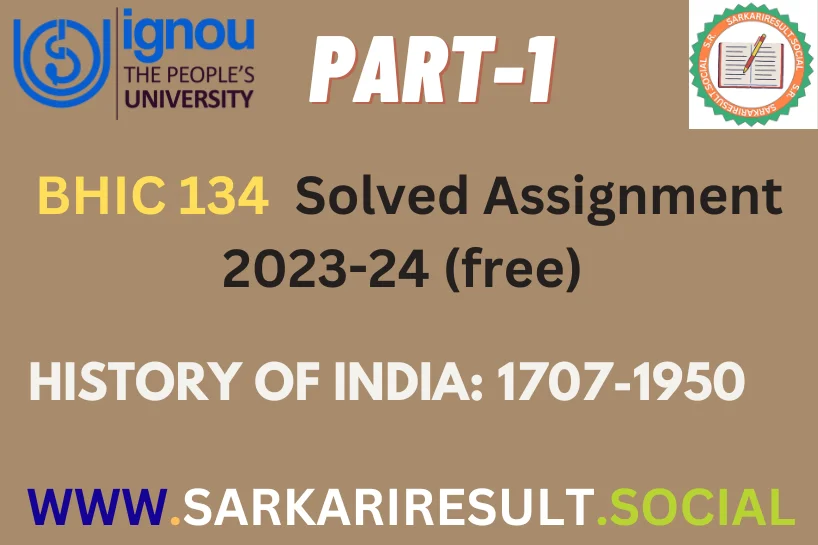BHIC 134 IGNOU Solved Assignment 2023-24 (free) Part -1

BHIC 134 IGNOU Solved Assignment 2023-24 (free) Part -1
Enhance your historical insight with BHIC 134 IGNOU Solved Assignment 2023-24 (free) Part -1, featuring two probing questions, each necessitating a comprehensive 500-word response. Our meticulous solutions maintain a scholarly tone, ensuring a thorough exploration within specified word limits. Dive into historical inquiries, fulfill the requirements with depth, and excel in your academic endeavors. Access BHIC-134 IGNOU Assignment 1 solutions to enrich your grasp of historical contexts and foster a more profound scholarly perspective.

1. Was the 18th century a ‘Dark Age’? Discuss.
Ans. The 18th century, often termed the “Enlightenment era,” witnessed significant intellectual, scientific, and cultural advancements, challenging the notion of it being a “Dark Age.” However, its characterization as a “Dark Age” varies based on different historical, regional, and contextual perspectives.
Also Read This: BHIC 133 IGNOU Solved Assignment 2023-24 (free) Part -1
Arguments against the ‘Dark Age’ label:
1. Intellectual and Scientific Progress: The 18th century saw the Enlightenment, marked by a surge in rationalism, scientific inquiry, and philosophical developments. Thinkers like Voltaire, Rousseau, and Montesquieu promoted reason, liberty, and the pursuit of knowledge.
2. Cultural Renaissance: Art, literature, and music flourished during this period. The works of literary giants such as Shakespeare, Voltaire, and Goethe, along with musical compositions by Mozart and Bach, enriched cultural heritage.
Also Read This: BHIC 133 IGNOU Solved Assignment 2023-24 (free) Part -2
3. Technological and Industrial Advancements: The Industrial Revolution emerged, transforming economies through mechanization, urbanization, and technological innovations, laying the groundwork for modernization.
4. Political Revolutions: Revolutionary movements like the American and French Revolutions fostered ideals of democracy, individual rights, and liberty, reshaping political structures and challenging the authority of monarchies.
Arguments favoring the ‘Dark Age’ portrayal:
Also Read This: BHIC 133 IGNOU Solved Assignment 2023-24 (free) Part -3
1. Social Inequalities: Despite advancements, societal inequalities persisted. The Enlightenment era largely benefited the privileged elite, while the majority of the population, including peasants and workers, faced poverty, exploitation, and harsh living conditions.
2. Colonialism and Slavery: European expansionism led to colonial conquests and the exploitation of indigenous populations. The transatlantic slave trade flourished, inflicting immense suffering on millions.
3. Conflict and Warfare: The 18th century witnessed numerous wars and conflicts, including the Seven Years’ War, contributing to devastation, loss of life, and societal disruption.
4. Opposition to Change: Resistance to Enlightenment ideals existed within traditional institutions, including the Church, aristocracy, and conservative thinkers, impeding progressive reforms.
Also Read This: BHIC 131 IGNOU Solved Assignment 2023-24 (free) Part -1
Conclusion:
The characterization of the 18th century as a “Dark Age” is multifaceted and context-dependent. While it was a period of significant intellectual, scientific, and cultural advancements, it was also marked by social disparities, exploitation, conflict, and resistance to change.
Considering both its achievements and shortcomings, labeling the 18th century solely as a “Dark Age” oversimplifies its complexities. It was a period of transition and transformation, with advancements paving the way for modernity while also perpetuating inequalities and injustices. Understanding this era requires a nuanced examination of its dual nature, acknowledging both its enlightening contributions and the darker aspects that challenged progress and equality.
Also Read This: BHIC 131 IGNOU Solved Assignment 2023-24 (free) Part -2
2. Discuss the nature of popular movements before 1857.
Ans. Before the Indian Rebellion of 1857, several popular movements emerged across India, reflecting diverse grievances and aspirations against colonial rule, socio-economic injustices, and cultural disruptions. These movements varied in nature, scope, and objectives but collectively contributed to the growing discontent and resistance against British dominance.
Peasant Uprisings:
1. Santhal Rebellion (1855-1856): Led by the Santhal community in present-day Jharkhand, this was a significant tribal uprising against land revenue policies, exploitation by moneylenders, and the colonial administration’s encroachment on tribal lands.
2. Indigo Revolt (1859-1860): Farmers in Bengal, notably in the indigo-producing regions, protested against the exploitative indigo cultivation system imposed by British planters, demanding fairer terms and rights.
Also Read This: BHIC 131 IGNOU Solved Assignment 2023-24 (free) Part -3
Socio-Religious Movements:
1. Sati and Widow Remarriage Movements: Efforts by reformers like Raja Ram Mohan Roy and Ishwar Chandra Vidyasagar to abolish the practice of Sati (widow immolation) and promote widow remarriage reflected social reform movements challenging traditional customs.
Resistance against Colonial Policies:
1. Opposition to Land Revenue Policies: Peasants and landowners resisted the exploitative land revenue policies introduced by the British, often resulting in revolts and protests against high taxation and land assessments.
Also Read This: Check BGDG 172 IGNOU solved assignment 2023-24 (Free)
2. Brahmo Samaj (1828): Founded by Raja Ram Mohan Roy, this reformist movement sought to reform Hindu society, advocating for monotheism, social reforms, and the rejection of idol worship and caste discrimination.
2. Anger against Economic Exploitation: The introduction of new economic policies, taxation, and the destruction of local industries led to resentment among artisans, weavers, and traditional craftsmen who faced economic hardship.
Regional Movements:
1. Maratha Resistance: The decline of the Maratha Empire and British expansion in Western India led to sporadic resistance and conflicts between the Marathas and the British, culminating in the Anglo-Maratha wars.
Also Read This: Check top Begae 182 IGNOU solved assignment 2023-24 (Free)
2. Punjab Unrest: Dissatisfaction among the Sikh rulers and nobility due to annexation policies, taxation, and cultural interference by the British fueled discontent in Punjab.
These diverse movements reflected the discontent, grievances, and resistance against British colonial policies, economic exploitation, cultural interference, and social injustices prevailing across different regions and communities in India. They laid the groundwork for the larger uprising of 1857, also known as the Indian Rebellion or the First War of Independence, uniting various grievances into a concerted challenge against British rule.







